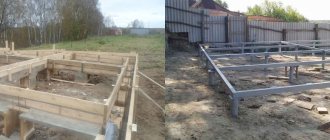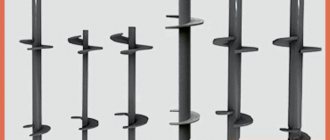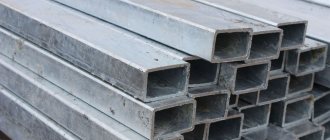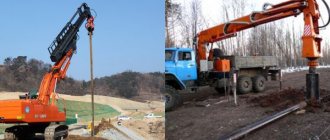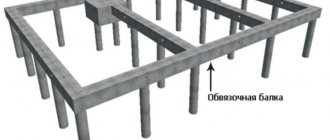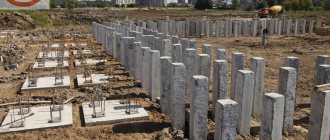In accordance with GOST requirements, it is necessary to carry out static tests of piles. Depending on the assigned tasks, certain methods are selected, with the help of which reliable results are obtained that allow drawing conclusions.
Upon completion of the work, experimental data are obtained, from which the relationship between settlement, i.e. vertical movement of the pile, and the load on it is determined. Stabilization by deformation is also determined, i.e., they find out how the settlement develops at each stage. Complex, labor-intensive work makes it possible to understand what load a pile can withstand so that the erected building is strong and durable.
If we consider all the methods by which piles are tested, it is tests with static loads that provide the opportunity to ensure high accuracy and reliability of the conclusions. Accordingly, conditions are created for the implementation of economically rational projects. It is important that decisions are made on the basis of actual results, and not approximate estimates.
In what cases are tests necessary?
The main goals for achieving which static tests are carried out:
- At the stage of construction of objects: determination of the bearing capacity of specific piles.
- In the process of research: searching for the most rational solution related directly to the design of piles, determining their placement locations, as well as the optimal quantity.
The requirements of GOST 5686-2012 determine the minimum number of piles for testing. There are the following requirements:
- up to 0.5%, but not less than two for indentation load tests, with the exception of some cases justified in the regulatory document;
- not less than 2% of the total, but not less than three when using a horizontal or pull-out load.
When a minimum number of tests have already been performed, a value is obtained that determines the partial minimum ultimate resistance. If different values are obtained in two tests, the minimum or average is considered.
To increase the load-bearing capacity, you will need to perform more tests and process the resulting statistics. As a result, the value of the soil reliability coefficient should be determined. This approach makes it possible to make geotechnical projects more economically efficient.
We carry out static and dynamic tests of bored piles in Moscow
Specialists perform static and dynamic tests of bored piles, as well as monitoring the continuity of concrete in Moscow and the Moscow region
This email address is being protected from spambots. You must have JavaScript enabled to view it.
Sale of tongue and groove
More details
Sheet piling
More details
Buy Larsen sheet piling Installation of strip foundations with bored piles Design of foundations for bored piles Turnkey bored foundation
In the process of installing bored foundations, a number of control measures must be performed.
Preparation for testing
It is important that the piles meet all the requirements for such products. A strength testing program is being developed, in accordance with which static tests are carried out.
The pile intended for testing with a destroyed head in the area with the defect must be cut off. The reverse side must be leveled, it is necessary to form a plane in it. Regulatory documents regulate possible deviations from design data.
If a pull-out load is to be used, the pile is first prepared in the required manner, which is selected in accordance with the specific method of load transfer.
It is practical to perform static tests in permafrost soils; standard and accelerated methods are used for them. Special thermal sensors allow you to determine soil temperature.
It is important that testers have experience working with subsidence and other complex soils. Before starting work, it is necessary to moisten the soil around the pile. GOST 5689-2012 clearly defines how to calculate the required amount of water.
Installation diagrams
GOST has many appendices that specifically explain which schemes should be used when testing piles. The most commonly used are the following:
- installation with anchor piles and a beam system, which becomes a reliable support for the jack;
- installation with a loading platform, which is used for similar purposes.
Features of using a system of beams and anchor piles, a loading platform
There is a weight on the platform, the dead weight of which is transferred to the pile as a jacking force.
The anchor piles bear the force of the jack through metal beams. The cross-section of the beams and their number are calculated so that the load on the pile is maximum. Ensuring stability and rigidity is a must.
The loading capacity of the loading platform limits its use. As a rule, it is no higher than 200 tons. It follows from this that if it is necessary to provide a greater force, a system consisting of beams and anchor piles should be used.
Test procedure
It is important that the loading of the test pile occurs evenly. Step loads or impacts should not be tolerated. When developing the program, the maximum load value is determined. During testing, a force is provided that should not exceed 1/10 of the calculated value.
When working on coarse soils, the deepening of full-scale piles can be allowed in three stages. The same rule applies to dense sands and clayey soils of dense consistency.
If the diameter of the pile is more than 80 cm, tests can be carried out separately for its lower end and side surface.
Test reports must be prepared - instrument readings at each loading stage are determined and recorded. The first report is generated before the load begins. The second - immediately after the start of loading, then - at certain time intervals, in accordance with the developed program.
It is important to consider that instrument readings should not differ more than the following values:
- 20% for precipitation more than 5 mm,
- 30% with precipitation 1-5 mm,
- 50% for precipitation less than 1 mm.
As a criterion for conditional stability, the settlement of the equipment at the current stage of loading is taken if it does not exceed 0.1 mm in an hour, provided that under the lower end there are soils belonging to the hard-plastic category. If the soils are clayey or loose, the time interval is doubled.
It is important to bring the load to such a value that complete settlement of the full-scale pile occurs in 40 minutes or more. If a probe or reference pile is in operation, then this time should be more than 20 minutes.
If precipitation is less, the check should continue for at least 5 hours, even if the accepted conditional stabilization was achieved earlier. This rule is mandatory if the program does not provide another time interval.
When working with dense or coarse soils, it is important that the load is brought to program values. However, it cannot be less than one and a half values of the indicator that the pile can withstand according to the documentation. Also, it should not be greater than the calculated resistance of the pile shaft material.
All types of piles are unloaded when the maximum load is reached. This is organized in stages. After passing each of them, instrument readings are taken. How to properly keep a log and record readings is described in the relevant GOST.
Methodology for testing bored piles of increased bearing capacity according to the Osterberg system.
Rolf Katzenbach, Doctor of Technical Sciences, Prof., Technical University of Darmstadt; R. A. Dunaevsky, project manager for Eastern Europe, Prof. Katzenbach Engineering Association; A.A.Franivsyushch Ph.D., NIISP, Kyiv.
In connection with the emergence of new technologies and types of piles, as well as new requirements for increasing their load-bearing capacity, especially in high-rise construction, there is a need to apply new methods for testing piles, allowing the installation of piles of increased load-bearing capacity to failure on the ground. Testing piles using hydraulic jacks and dividing the pile into segments is advisable for piles with increased load-bearing capacity, when bringing the pile to failure on the ground using classical pile tests provided for by the existing regulatory framework is technically impossible and/or it is necessary to use bulky anchor structures, and Carrying out tests is inappropriate from an economic and technical point of view. Figure 1 shows the anchor structure for static testing of a pile for a load of 3000 t.
| Fig.1. Anchor structure for static testing of piles for a load of 3000 t. | |
The use of tests using hydraulic jacks is more economical compared to classical pile tests, the higher the loads and, accordingly, the more complex the production of the anchor structure. Carrying out this type of testing is possible on cast-in-place piles, if the fastening of hydraulic jacks is provided during the manufacture of the test pile at a concrete plant, on piles made of pipes, etc. Today, the use of this technology is most widespread for bored-in-place piles of large diameters (> 600 mm) and foundations of the “Barrett” type (Fig. 2).
| Fig.2. Testing of barrettes using hydraulic jacks and dividing the pile into segments. | |
Conducting tests using hydraulic jacks and dividing the pile into segments is difficult or impossible today for wooden piles, inclined piles and piles that transfer horizontal loads.
As with classical pile testing, it is recommended to produce the tested piles using the same technology that is intended for subsequent use at the construction site.
In addition, testing piles using hydraulic jacks and dividing the pile into segments is often used in special hydraulic engineering, port construction, bridge construction, etc., when piles must be made in water areas or in conditions where the future construction site is surrounded by water and the device required anchor piles is technically difficult and/or economically infeasible. In addition, it is also advisable to carry out this type of testing during construction in cramped conditions.
Carrying out tests using hydraulic jacks and dividing piles into segments allows, under a certain scheme, the application of cyclic loads, as well as the study of soil creep.
Bringing the pile to failure along the ground during testing and determining the design characteristics of soils using the solution of the inverse problem allows you to create a reliable and economical foundation design. This article describes a fundamentally new approach to testing piles using hydraulic jacks and dividing the pile into segments, which are mounted on the reinforcement frame of the pile under test and drive the pile segments to failure at a predetermined depth and in the most characteristic soil layers in terms of bearing capacity.
In this case, it is possible to accurately determine not only the total load-bearing capacity of the pile in soil layers, but also a differentiated determination of its component quantities: friction along the lateral surface and resistance under the lower end of the pile.
Test design
When designing tests of a pile using hydraulic jacks and when dividing it into segments, special attention should be paid to the study of the engineering-geological structure of the soil mass in the designed area.
Before testing, it is necessary to determine soil layers with high bearing capacity that have sufficient distribution at the design depth and the built-up area
As part of the research, it is especially important to identify possible zones of heterogeneity in the geological structure of soils, such as weathering zones, alternation of soil layers, etc. These data must be taken into account when designing tests using hydraulic jacks and dividing the pile into segments to obtain accurate design characteristics for a particular soil layer.
As part of the test design for the purpose of the most accurate preliminary assessment of friction on the lateral surface and load-bearing capacity under the lower end of the pile for load-bearing soil layers, it is necessary to draw up a well-founded program for studying these layers using laboratory and field tests, as well as an analysis of technical literature and existing construction experience in the data and similar ground conditions.
It is also advisable to use the results of static sounding to evaluate soil layers with similar bearing capacity. For a preliminary assessment of the load-bearing capacity of a pile on the ground, it is advisable to use the tables given in the regulatory literature, especially when these tables take into account construction experience in a given region.
Based on the results of assessing the bearing capacity of soils, the dimensions of the segments of the tested pile should be determined. It must be taken into account that the segments, depending on the test scheme (each individually or several segments together), must work both as the test structure and as an anchor structure.
In this regard, it is especially important to involve expert organizations with relevant experience in the design of such pile tests.
Taking into account the bearing capacity of the soil, the material of the pile segments should be selected, as well as the power and number of hydraulic jacks.
When designing tests, it must be taken into account that for it to be successful, the calculated load-bearing capacity of the pile segment material must be higher than the maximum estimated load-bearing capacity of the pile segment on the ground.
Test scheme
The test principle boils down to the fact that one segment is pressed in with a jack, the other is an anchor structure. In this case, the installation of any other anchor structure, as in the classical static test of piles, is not required.
| Fig.3. Test circuits: one level of jacks on the left and two levels of jacks on the right. |
It is advisable to carry out tests according to the following schemes (Fig. 3):
- single-level , in which one level of jacks is used, with the help of which the resistance under the lower end and friction along the side surface for the upper segment are determined, i.e. The structure of the tested pile consists of two segments. If the load-bearing capacity under the lower end of the pile is low, it is possible to choose the length of the lower segment so that it works together in terms of the load-bearing capacity under the lower end of the pile and along the side surface. A differentiated determination of the component values of the bearing capacity of a pile: friction along the lateral surface and resistance under the lower end of the pile is carried out by subsequent analysis of the results. At a certain ratio of friction along the lateral surface and the bearing capacity under the lower end of the pile, the upper segment can be approximately equal in length to the length of the designed pile;
- two-level , in which two levels of jacks are used, i.e. the upper segment is pushed upward by jacks, and the anchor structure is the two lower segments. After the completion of the first phase of testing, the jacks remain open and the middle segment is pushed upward, while the anchor structure is the lower segment, which operates predominantly on the load-bearing capacity under the lower end of the pile. When designing a test according to such a scheme, it is necessary to take into account possible deformations of the middle segment of the pile and include in the design the appropriate free play of the jack in order to prevent unwanted load transfer to the upper segment of the pile in the second phase of the test. The third phase is carried out in a similar way to a single-level test, with the middle and upper segments being the anchor structure when closing the upper jacks. Similar to the two-level test, it is possible to conduct tests at more than two levels.
When carrying out tests using hydraulic jacks and dividing the pile into segments, special attention should be paid to controlling deformations. To reduce the influence of temperature on measuring instruments, the test site must be protected from weather conditions.
Strain gauges are installed in each pile segment along its entire length, which transmit data to the surface. As a result of computer processing of this data, the deformation of concrete is determined, which is accordingly taken into account when calculating the bearing capacity of soils. To monitor general deformations, an extensometer is installed in the structure of the pile being tested. Devices for measuring displacements are also provided at the installation levels of the jacks. Data from these devices is also transmitted to the surface and subject to computer processing. Thus, it is possible to determine the deformation along the entire length of the segment operating on friction along the lateral surface, which provides a differentiated calculation of this parameter depending on the depth of the pile segment.
Testing a pile according to the schemes described above requires expert support.
In most cases, it is not recommended to use the pile under test as an element of the foundation structure. After testing, the pile segments can be considered as an element of the foundation structure only if the upper segment of the pile is equal to the length of the pile and additional measures are provided, such as injection of cement mortar into the area of the jacks. It should be taken into account that the load-bearing capacity of the pile on the ground decreases. To control the integrity of the pile material, it is necessary to test the concrete non-destructively.
Experience in testing piles using hydraulic jacks and dividing the pile into segments
Testing of piles using hydraulic jacks and dividing the pile into segments is widely used on the most significant construction projects.
As part of the Frankfurt4 project (Germany), a pile was tested using a two-level scheme in Frankfurt limestone rocks (Fig. 4). In this case, injections were carried out at the level of the middle segment of the pile to increase friction along the lateral surface.
| Fig.4. Results of tests of piles using hydraulic jacks and dividing piles into segments according to the Osterberg system in Frankfurt am Main. | |
As a result of the test, all segments of the pile were driven to ground failure. The following values have been measured in Frankfurt limestone:
• maximum friction on the lateral surface without injection - 830 kN/m2;
• maximum friction on the lateral surface with injection - 1040 kN/m2;
• maximum resistance under the lower end of the pile is 7000 kN/m2.
| Rice. 5. Testing of piles using hydraulic jacks and dividing the pile into segments according to the Osterberg system in Moscow. |
Tests and instrumentation followed the Osterberg method.
Similar tests in a limestone massif were carried out in Moscow during the construction of the Federation Tower (Fig. 5).
In 2006, for the first time in Ukraine, piles were tested using the technology described above during the construction of the Solomenka international Business Park in Kyiv (Fig. 6).
| Rice. 6. Testing piles using hydraulic jacks and dividing the pile into segments according to the Osterberg system in Kyiv. |
Tests were carried out on segments of a bored pile produced under a clay solution in Kyiv marl clay at a depth of 32-37 m with an index of IL = 0.2.
As a result of the test, the following indicators were obtained:
• maximum friction on the lateral surface - 80 kN/m2;
• maximum resistance under the lower end of the pile is more than 3025 kN/m2.
Conclusions and recommendations
Testing piles using the Osterberg method is advisable for high load-bearing capacity of piles and heavy loads.
The above pile testing method does not require the production of ground anchors or anchor piles. The anchor pile is the tested segment. When designing tests, it is important to correctly assess the relationship between friction on the lateral surface and the load-bearing capacity under the heel of the pile and, in accordance with this, select the lengths of the segments and the maximum loads for the jacks.
When testing in new soil conditions, it is advisable to use tests at several levels.
Based on the results of such tests, a new approach to foundation calculations is possible, i.e. As a result of full-scale tests, not only the overall load-bearing capacity of a pile with predetermined dimensions is known, but also an accurate understanding of its individual components for certain soil layers.
In relation to the soil conditions of Kyiv, it is planned to conduct similar tests in the sands of the Buchakovskaya and Kanevskaya formations to accurately describe the bearing capacity of these soils.
Due to the frequent use of barette foundations in high-rise construction in the cities of Ukraine, it is also planned to conduct tests using the Osterberg method for this type of foundation.
The values of friction on the lateral surface and resistance under the lower end of the pile obtained as a result of tests using hydraulic jacks can be used instead of tabular ones when calculating according to SNiP 2.02.03-85 “Pile foundations”. In this case, the ground reliability coefficient can be taken in accordance with the tests performed.
Use of static pull-out load
If the future foundation is expected to experience uplift stresses, similar loads are used to control foundation stability. To carry out such tests, composite and concrete piles are not used. Also, piles with a widened heel, prestressed without transverse reinforcement, or screw piles are not taken.
The criterion for conditional deformation stabilization refers to the speed at which the pile will emerge from the ground. The program prescribes several stages of influence. For piles of foundations of structures and buildings, with the exception of bridges, there should be no more than 0.1 mm over the past two hours. For bridges, a period of one hour is taken.
The load must reach such values that the pile rises by at least 25 mm. The test program determines the maximum impact value.
The design of a pile foundation includes a calculated load on the pile. Accordingly, during testing the forces should not exceed it. GOST determines the procedure for recording indicators obtained during the experiment.
Static test technology
Testing of piles, in accordance with the requirements of the standard, is carried out according to the following algorithm:
- A program and methodology for performing the test is being developed, containing information about the maximum force transmitted to the structure, the load distribution step, which should be 10% of the mass of the calibrated load.
- The design organization determines the number of products for testing soils with piles and the places for their driving.
- In the future pile field, a group of piles is driven in areas corresponding to the worst, most unfavorable conditions or places where failures occurred during driving.
- A loading structure and a set of equipment that ensures the transmission of forces are being installed.
Static tests of piles
Static load testing of piles involves three stages of work:
- preparing the support to be tested;
- testing production;
- processing of received information.
The preparation process, according to GOST, involves laying down, that is, “rest”, the duration of which is:
- 1 day if diving is carried out in dense layers of sand or coarse clastic masses.
- 3 days for sandy substrates.
- 6 days for clay surfaces and heterogeneous masses.
- 10 days for water-saturated and fine sands.
- 20 days for fluid, plastic and soft clay fractions.
Testing of piles, according to the provisions of the document, represents a sequential increase in load. The amount of immersion in a dense soil mass during the first loading cycle can be a fifth of the total mass of the calibrated cargo. The force is applied when stabilizing the position after the previous load cycle. The control of the settlement value is checked using dial gauges and electronic devices, the division value of which is 0.1 millimeter. Before applying force, the data of all devices is reset and after each load cycle the readings of all devices are monitored. The criterion for position stabilization is movement at a distance of no more than 0.1 millimeter during the last 60-120 minutes of observation.
During the test, peak force values are applied, at which the full-scale sample sags more than 40 millimeters, and the reference products are buried into the ground by 20 mm or more. The force value at which the loading is stopped is the value of the partial ultimate resistance.
The measurement results are recorded in the observation log. After completing the tests, graphs are drawn that allow conclusions to be drawn about the required number of supports, their geometry, and depth. Measurement data is the basis for designing the foundation of a future building.
How to use static horizontal load
In order for instruments to accurately perform measurements, they are installed in planes that are parallel to the direction of the force. At least two levels are used for this: the ground surface, the place where the load is applied. The program can also specify a larger number of places for using devices.
Testing and recording of results occur in the same way as with the pressing load method. The impact must reach such a force that the horizontal movement of the pile begins. The force must be greater than the level of load on the piles calculated by the designers.
How the tests are prepared
If the soils are permafrost, it is important to prevent the pile from freezing with them. To achieve this, a number of activities are provided; drilling with dimensions exceeding the diameter of the equipment, sinking a hole, etc.
After the piles are immersed in such soils, the temperature is measured once a week along the entire length at intervals of one meter or less. Tests when working with driven and bored piles should begin at least a week after their installation. Research when working with bored concrete begins when the concrete reaches 80% of the strength planned in the project.
Loading should also be organized evenly, without shock, by increasing the force in steps. The test program determines the load level, but the force should not be less than 1/5 of the maximum design load. Indicators are taken at each stage and recorded in a log in accordance with GOST requirements. It is mandatory to withstand each loading stage until the deformation is conditionally stabilized. This period cannot be less than 24 hours.
The criterion for conditional stabilization is a shrinkage rate not exceeding 0.2 mm over 24 hours.
It is imperative that the load reaches a value at which there is no deformation stabilization at a certain stage of application of force. The experiment can only be completed when the settlement rate is three times or more that which was obtained in the previous stage. Unloading is also organized in stages. There should be 15 minutes or more between changes in effort.
It is important that experiments with piles are carried out at natural soil moisture. In subsidence soils, wetting can be carried out first. How much water to use is described in regulatory documents.
Sometimes it is possible not to soak the soil, but this requires appropriate justification.
Soaking the soil is a mandatory condition for testing piles
Static tests are preceded by such a mandatory procedure as saturating the soil with moisture. This requires the construction of special trenches, which are dug along the perimeter, at a distance of one meter from their side surfaces. The optimal width of such a trench is 0.5 meters and the depth is 1-1.5 meters.
If the length of the tested sample exceeds 6 meters, for better and faster soaking it makes sense to drill 3 wells located around the perimeter. Their optimal diameter is 20 cm. During the entire time of testing the supports in a trench or drainage well, it is necessary to maintain a constant water level. You should be prepared for the fact that the amount of water that will be consumed during the test will be quite significant.
For high-quality soaking you will have to spend at least 20 m3 per meter. The time required for the soil in the testing area to become saturated with moisture must also be precisely maintained. As a rule, it is at least 24 hours for each meter of depth, but may vary depending on the specific characteristics of the soil. The final readiness of the soil can be determined by drilling and testing the soil within a radius of 1 meter from the support.
